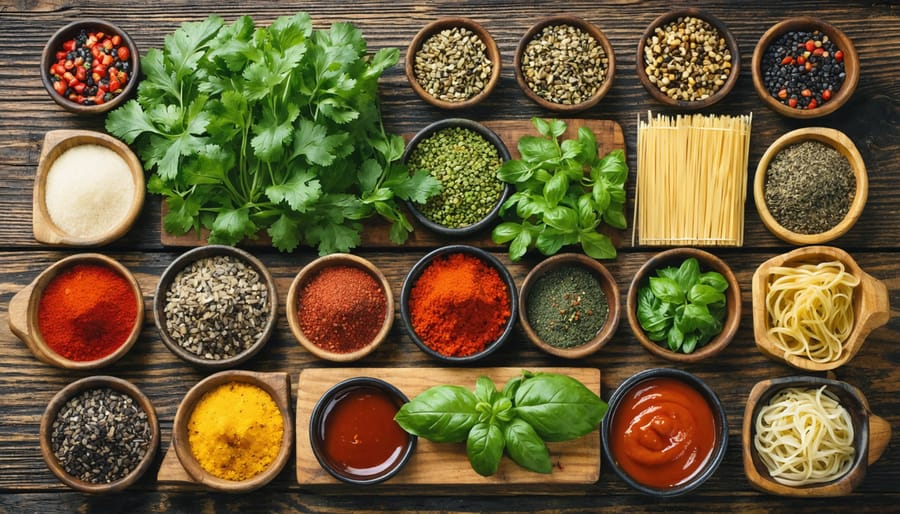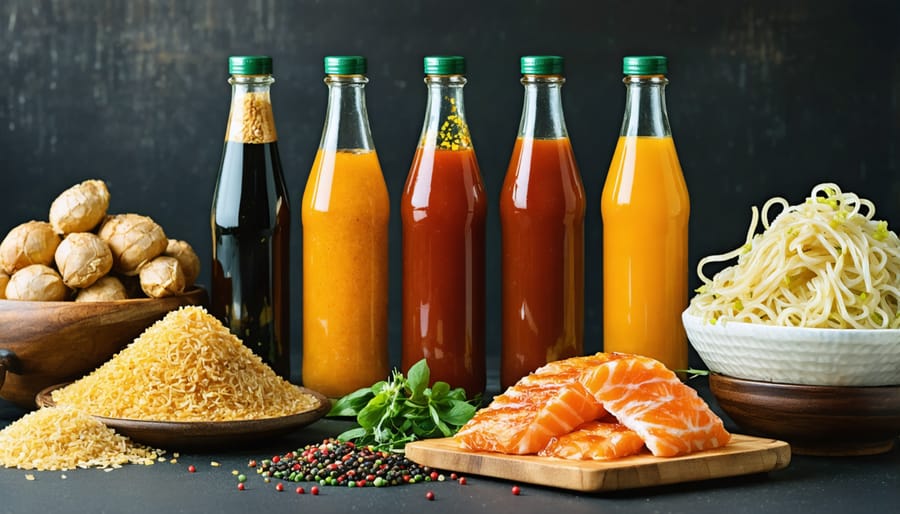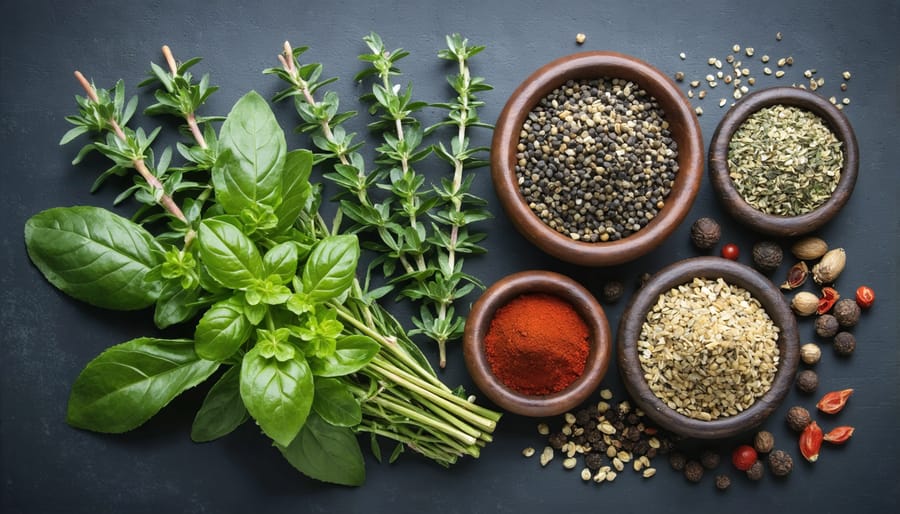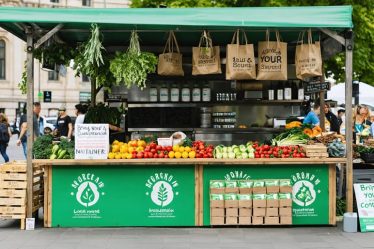
Step onto any bustling street corner in Bangkok, breathe in the aromatic spices wafting from Mexico City’s food carts, or follow the sizzling sounds in Istanbul’s bazaars – street food tells the most authentic stories of a culture’s culinary heart. As someone who’s spent years learning to recreate authentic flavors at home, I’ve discovered that the magic of international street food lies not just in the ingredients, but in the techniques passed down through generations.
From crispy Vietnamese bánh mì to steaming plates of Moroccan tagine, these beloved street eats represent more than just quick meals – they’re edible history, crafted by vendors who’ve perfected their signature dishes over decades. The best part? You don’t need a plane ticket to experience these flavors. With some creativity and the right guidance, your kitchen can transform into a global street food paradise.
Whether you’re craving the punch of Thai pad kra pao or the comfort of Argentine empanadas, we’ll explore how to source traditional ingredients locally, master time-honored cooking techniques, and bring the vibrant energy of the world’s food streets into your home. Get ready to embark on a delicious adventure that proves the best meals often come from the humblest of kitchens.

Asian Street Food Essentials
Thai and Vietnamese Staples
The heart and soul of Thai and Vietnamese street food lies in its foundational ingredients, which bring those unforgettable flavors we all crave. As someone who’s spent countless hours exploring Asian culinary traditions, I’ve learned that these staples are absolutely essential for authentic cooking at home.
Fish sauce, or “nam pla” in Thai, adds that perfect umami punch to dishes. While premium brands like Red Boat are worth the splurge, you can find good alternatives in most Asian markets. Look for a clear, amber color and check that fish is the first ingredient listed. If you can’t find fish sauce, try mixing anchovy paste with a bit of salt as a substitute.
Palm sugar brings a complex sweetness that regular sugar just can’t match. Its caramel notes are crucial in balancing spicy and sour flavors. Brown sugar mixed with a touch of maple syrup can work in a pinch, though the flavor won’t be quite the same.
Rice noodles are wonderfully versatile, but quality matters. For best results, look for noodles made from just rice and water. They should be translucent and feel smooth, not powdery. If your local store doesn’t stock them, Japanese udon or even angel hair pasta can work for some dishes – just adjust your cooking time accordingly.
Remember, while traditional ingredients are ideal, don’t let their absence stop you from experimenting. The joy of cooking lies in making these recipes your own!
Chinese and Korean Must-Haves
Let me share a little secret from my adventures in Asian cooking: mastering street food starts with stocking your pantry with the right essentials. For Chinese dishes, dark soy sauce and oyster sauce are absolute must-haves – they’re the dynamic duo that creates that rich, umami-packed flavor we all love in stir-fries and noodle dishes. If you can’t find oyster sauce, mushroom-based vegetarian versions work beautifully too!
Gochugaru (Korean red pepper flakes) and gochujang (fermented red pepper paste) are the heart and soul of Korean street food. I remember being intimidated by these ingredients at first, but now I couldn’t imagine my kitchen without them! For those who find gochugaru too spicy, regular red pepper flakes mixed with a touch of paprika can work in a pinch.
Don’t forget aromatics like Chinese five-spice powder, sesame oil, and fresh ginger – they’re game-changers for authentic flavor. Korean pantry essentials should include doenjang (fermented soybean paste) and toasted sesame seeds. If you’re having trouble finding doenjang, miso paste makes a great substitute, though the flavor will be slightly milder.
For both cuisines, having good quality neutral oil (like grapeseed or vegetable) and rice vinegar on hand is essential. Most of these ingredients are now available in regular supermarkets, but Asian grocery stores often offer better variety and value. Plus, shopping at these specialty stores can be such a fun adventure!
Mediterranean Street Flavors
Herbs and Spices
The vibrant world of Mediterranean street food owes much of its magic to the aromatic herbs and spices that transform simple ingredients into unforgettable dishes. Walking through any Mediterranean market, you’ll be greeted by the enchanting scents of za’atar, sumac, and fresh herbs wafting through the air.
One of my favorite discoveries was learning how easy it is to grow many of these herbs right at home. Oregano, thyme, and rosemary are particularly hardy and thrive in sunny windowsills or small garden spaces. Even if you’re working with limited space, these Mediterranean staples can flourish in small pots, providing fresh flavors year-round.
For those signature spice blends like za’atar (a mix of dried herbs, sesame seeds, and sumac) or ras el hanout, you have two wonderful options. Either blend them yourself using readily available ingredients from your local specialty store, or look for authentic versions at Middle Eastern markets. Pro tip: when buying pre-made blends, smell them first – fresh spices should have a strong, pleasant aroma.
Don’t feel constrained by traditional recipes. If you can’t find fresh mint for your falafel sauce, basil can work beautifully. Similarly, dried herbs can stand in for fresh ones in many cases – just remember to use about one-third of the amount called for in recipes, as dried herbs are more concentrated.
Store your herbs and spices in airtight containers away from direct sunlight, and they’ll reward you with months of authentic Mediterranean flavors right in your own kitchen.

Specialty Items and Substitutes
I remember the first time I tried to make authentic pad thai at home and couldn’t find tamarind paste anywhere in my local stores. It’s a common challenge we all face when trying to recreate our favorite street foods, but don’t worry – I’ve got you covered with some clever substitutions that won’t compromise on flavor!
For those hard-to-find Asian ingredients, like palm sugar, regular brown sugar mixed with a touch of maple syrup creates a similar caramel depth. Can’t source galangal for your Thai curries? Ginger with a pinch of pepper works wonderfully. When banana leaves aren’t available for Mexican tamales, parchment paper or aluminum foil steps in perfectly.
Middle Eastern shawarma traditionally uses sumac, but a mixture of lemon zest and salt captures that same tangy brightness. For Indian chaat masala, a blend of cumin, black pepper, and citric acid powder creates that signature tang. Mexican epazote can be replaced with a combination of oregano and thyme in your street tacos.
Remember, while traditional ingredients are ideal, cooking is about creativity and adaptation. Many ethnic grocery stores now offer online shopping, making specialty items more accessible than ever. And here’s a tip I learned from my grandmother: build relationships with local international market owners – they often stock items on request and can guide you to perfect substitutes.
Latin American Street Food Components
Mexican Street Food Basics
I fell in love with Mexican street food during my first visit to Mexico City, and I’m excited to share these essential ingredients that bring authentic flavors to your kitchen. Don’t worry if you can’t find everything – I’ll share some clever substitutions that work just as well!
The heart of Mexican street food starts with corn masa, the dough used for tacos, tlayudas, and sopes. While fresh masa is ideal, masa harina (corn flour) mixed with water creates a perfect alternative. For those amazing street tacos, you’ll want small corn tortillas – they’re different from the larger dinner ones you might be used to.
Essential seasonings include dried chilies (like guajillo and ancho), Mexican oregano, and fresh cilantro. Can’t find Mexican oregano? Mediterranean oregano works in a pinch, though the flavor is slightly different. For that authentic street food kick, keep lime wedges, white onions, and fresh jalapeños on hand.
When it comes to proteins, marinaded meats are key. Al pastor typically uses achiote paste for that distinctive red color and flavor. If you can’t source it locally, a blend of paprika and other spices can work. Don’t forget queso fresco for topping – while not exactly the same, crumbled feta makes a good substitute.
For those authentic salsas, tomatillos are crucial. If fresh ones aren’t available, canned varieties work wonderfully. Remember, the magic of Mexican street food lies in fresh ingredients and bold combinations – even with substitutions, you can create amazing flavors at home!
South American Flavors
The vibrant streets of South America are a treasure trove of mouthwatering flavors, and I still remember the first time I tasted a perfectly crispy empanada from a street vendor in Buenos Aires. The secret to authentic South American street food lies in its distinctive ingredients, many of which might seem unfamiliar at first but are actually quite accessible here at home.
Let’s start with the basics: corn is king in South American cuisine, but not just any corn. Look for masa harina, the special corn flour that gives arepas their distinctive texture. Most international grocery stores stock it, and I’ve even spotted it in the ethnic foods aisle of mainstream supermarkets. Plantains, both green and sweet varieties, are another staple you’ll find in the produce section – they’re perfect for making crispy tostones or sweet platanos maduros.
For those incredible Brazilian pão de queijo (cheese bread), you’ll need tapioca flour, which is becoming increasingly common in local stores. And don’t forget ají amarillo, the sunshine-yellow chili paste that gives Peruvian street food its unique kick. While the fresh peppers might be hard to find, the paste version is readily available in Latin American markets.
Here’s a little tip from my own kitchen adventures: if you can’t find a specific ingredient, local Latin American restaurant owners are often happy to share their supplier information. I’ve discovered some amazing little shops this way, and it’s a wonderful opportunity to connect with our local food community.
Where to Shop: Your Local Source Guide

Ethnic Markets and Alternatives
Don’t let the hunt for authentic ingredients discourage you from creating amazing international street food at home! While sourcing local ingredients can seem challenging at first, I’ve discovered some fantastic tricks over the years.
Start by exploring ethnic markets in your area – these hidden gems often stock ingredients you won’t find elsewhere. I remember feeling overwhelmed during my first visit to an Asian market, but the staff was incredibly helpful and even shared their favorite cooking tips! Pro tip: take photos of ingredient labels in their original language; this makes future shopping trips much easier.
Can’t find a specialty store nearby? Many regular supermarkets now have international aisles that carry basic ethnic ingredients. Look for alternative ingredients that can work just as well – Greek yogurt can substitute for Indian dahi, and Mexican chilies often work perfectly in Asian dishes. Some stores even allow you to request specific products, so don’t be shy about asking!
Online specialty food retailers are another excellent option, especially for shelf-stable ingredients. I often stock up on harder-to-find spices and sauces this way. You might even discover a community of food enthusiasts in your area who share tips about where to find specific ingredients or organize group orders from specialty suppliers.
Remember, authenticity is important, but don’t let perfect be the enemy of good. Sometimes, creative substitutions can lead to delicious new variations of classic street foods!
Online Sources and Storage Tips
Finding authentic ingredients for international street food can feel like a treasure hunt, but I’ve discovered some fantastic online resources that make it so much easier! My go-to websites include Amazon’s International Foods section, which often stocks hard-to-find spices and sauces, and specialty retailers like Asian Food Grocer and MexGrocer for region-specific ingredients.
For those special ingredients you’ve tracked down, proper storage is key to maintaining their authenticity. I learned this the hard way when my precious saffron lost its flavor because I didn’t store it correctly! Keep dried spices in airtight containers away from direct sunlight and heat – your kitchen cabinet is perfect. For fresh herbs and aromatics like lemongrass or kaffir lime leaves, wrap them in slightly damp paper towels and store them in resealable bags in the refrigerator.
Many specialty sauces and pastes can last longer when refrigerated after opening. I always write the opening date on the container with a marker – it’s a simple trick that’s saved me more times than I can count! For dried noodles and grains, transfer them to airtight containers to prevent moisture and unwanted visitors.
Remember, many ethnic grocery stores now offer online shopping with nationwide shipping. Join local food groups on social media – fellow food enthusiasts often share their trusted sources for specialty ingredients, and you might even discover some hidden gems in your own neighborhood!
As we’ve explored together, street food represents more than just quick, affordable meals – it’s a vibrant tapestry of global culinary traditions that tells stories of culture, community, and creativity. From the sizzling satay stalls of Southeast Asia to the aromatic tacos of Mexico, these beloved dishes have earned their place in the hearts of food lovers worldwide.
While authentically recreating these flavors at home might seem daunting at first, remember that every street food vendor started somewhere. Don’t be afraid to experiment with international cooking in your own kitchen. Start with simple recipes and gradually build your confidence and ingredient collection.
The beauty of modern cooking lies in our ability to adapt traditional recipes while honoring their essence. If you can’t find specific ingredients locally, embrace creative substitutions that capture similar flavors. Join online cooking communities, connect with fellow food enthusiasts, and share your experiences – you might discover new techniques or ingredient alternatives you hadn’t considered.
Most importantly, approach your street food cooking journey with curiosity and joy. Whether you’re mastering the perfect pad thai or creating your first batch of homemade empanadas, each attempt brings you closer to understanding these beloved global dishes. So fire up that stove, gather your ingredients, and let the world’s street food traditions inspire your next culinary adventure!



